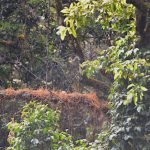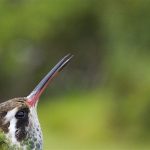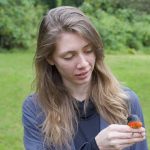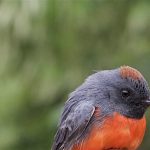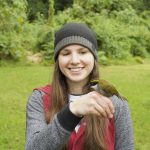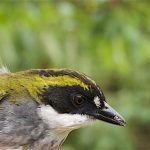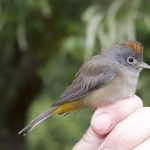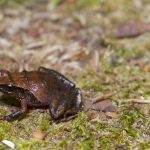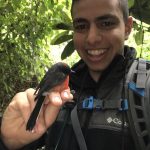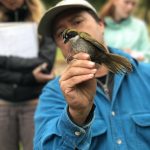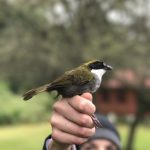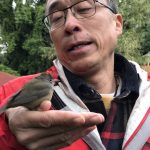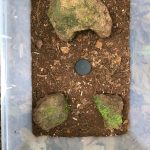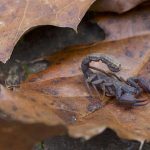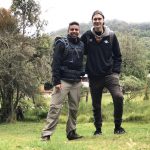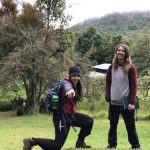ENGLISH
Blog Post Team TBD (Tequila BioDiversity) February 17th 2017
Hola! Today we woke up to a dewy morning accompanied by melodic bird songs. A group of early risers gathered to go set up the mist nets at 7:00am. We started our day with tasty breakfast empanadas, beans and fresh fruit. This was one of our chillier days here in Los Joyas, but that did not stop us from spending the day exploring the trails. We retrieved our catches from the mist nets to find the unique white-eared hummingbird, slate throated redstart, colima warbler, MacGillivray’s warbler and green striped brush finch. A fascinating adaptation in the slate-throated redstart is their ability to expand their tail feathers and startle insects, thus flushing them out to eat. The green striped brush finch is an endemic ground-dwelling species that the forest depends on. Dr. Javier Salgado showed us how we can use their iris colour as an indicator of age, with juveniles having grey irises and matured adults having brown. Amanda tried to make acquaintances with the green striped brush finch, but was greeted with an aggressive bite. Additionally, today was the day we discovered that Dr. Wang was a bird whisperer. The colima warbler was uncooperative and reluctant to be in the hands of humans until Dr. Wang handled the bird. It is safe to say we will keep him around for our hopeful voyage to bird island next week.
After releasing all the birds, we spent a few hours working on our group research projects. The Tequila BioDiversity group conducted experimental trials on beetles in the mesophilic forest and were lucky enough to see three deer (and perhaps a fourth ghost deer?!), a catydid and a scorpion. Meanwhile, (Amanda and) Da Boiz group were collecting frogs and running trials to test if different colour morphs of frogs preferred different substrate as camouflage. While the Aguila Elegante group was in the forest measuring tree trunks for their structural vegetation hypothesis, an unfortunate member decided to take a slip through the forest. Maybe they could test a second hypothesis – if a Rachel falls in the forest, will anyone be around to hear? Papi’s group were researching the physiological differences in streams and how they relate to invertebrate diversity. A sighting of a mountain trogon was made by Meruchent Internacional while trudging through the forest measuring herbivory rates related to patch size.
As our stomachs were grumbling more and more, we were finally greeted with lunch time, and suffice to say it was worth the wait. We feasted on sausages, steak, guacamole and fresh cucumber juice. This was our first taste of Mexican guacamole, and the Canadian reviews were amazing. After lunch we were on a mission to find snakes, and were especially eager to find the venomous red coral and Campbell’s rattlesnake. Unfortunately, after a thorough search through the trails we returned empty-handed (despite close encounters with a blue-tailed mystery lizard – likely a skink), likely due to the overcast weather preventing snakes from basking in the sun. We gathered in our research project groups for the remainder of the afternoon to continue collecting data.
Just before dinner, we had three seminar presentations covering the topics of intertidal zones, marine coastal diversity and gap dynamics. These insightful discussions grew our appetite and we were ready for our bacon-wrapped hotdog dinner. Our vegetarian friends enjoyed a delicious tofu and zucchini hot dog. We wrapped up our long day with three seminar presentations on co-evolution, biodiversity hotspots and ecotourism. As bed time rolled around, we all returned to our cabin to rest up for the next big day. Buenos noches!
ESPAÑOL
Blog del equipo (Tequila Biodiversity) Febrero 17 del 2017
Hola! Hoy despertamos con una mañana humeda acompañada de los melodiosos cantos de la saves. Un grupo de tempraneros nos reunimos par air a abrir las redes a las 7:00am. Iniciamos más tarde con un rico desayuno de empanadas, frijoles y fruta fresca. Fue uno de los días más frescos en Las Joyas, pero eso no nos detuvo de pasar nuestro día explorando los senderos. Fuimos a reviser las redes y encontramos un Colibrí oreja blanca, un pavito y un chipe de Colima y otro de mcgilvery y un rascados de dorso verde. Una adaptación facinante del pavito es su habilidad de expander sus plumas de la cola para espantar insectos y luego atraparlos y comerselos. El rascador de dorso verde es una especie endemic dependiente de bosque. El Dr. Javier Salgado nos explicó que se puede determiner la edad del ave por el color del iris, siendo de color gris en juveniles y café obscure en los adultos. Amanda trató de hacerse la chistosa con el rascador, pero este la recibio con unos picotazos. Descubrimos además que el Dr Wang era un murmullador de pájaros. El chipe de Colima no cooperaba y se resistía a estar en manos de los humanos hasta que el Dr. Wang la tomó en sus manos. Es seguro decir que lo mantendremos en nuestro viaje a la isla de pájaros la próxima semana.
Después de liberar todas las aves, pasamos tiempo trabajando en los proyectos de grupo. El grupo “Tequila Biodiversity” realizamos experimentos con escarabajos en el bosque mesófilo y tuvimos suerte de ver tres venados (tal vez un cuarto fantasma), un saltamontes y un scorpion. Mientras tanto, el equipo de Amanda “and Da boiz” estaban colectando ranas y hacienda experimentos para determiner si diferentes morphos de color prefieren difeentes sustratos como camuflaje. Mientras el grupo del Águila elegante estaba en el bosque midiendo troncos para su estudio de la hipótesis de la estructura de la vegetación, mientras un infortunado miembro se dió un resbalón en el bosque. Tal vez podrían probar una segunda hipótesis. Si una Rachel se caé en el bosque habrá alguien para escucharla?. El grupo de Papi, estaban determinando si las condiciones del arroyo tiene efectos sobre la diversidad de insectos. El equipo de Meruchent Internacional observaron un Trogón de Montaña mientras hacian su estudio de herbivoría relacionado al tamaño de parche.
Mientras nuestros estomagos nos rugian de hambre, finalmente fuimos a comer y suficiente decir que valió la pena esperar. Nos sirvieron un buffet de carne asada, salchichas, guacamole y agua fresca de pepino. Fue nuestra primera prueba de guacamole mexicano y los comentarios canadienses fueron muy Buenos. Despues de la comida nos fuimos en una mission de buscar serpientes y estabamos ansiosos de buscar la serpiente cascabel de Campbells. Despues de una búsqueda intensa no encontramos nada y nos regresamos con las manos vacias ( a pesar de un encuentro con una lagartija de cola azul isteriosa), seguramente por el clima frío en el cual no salen las serpientes a asolearse. Nos volvimos a reunir en nuestros proyectos de grupo por el resto de la tarde para seguir colectando nuestros datos.
Justo antes de la cena, tuvimos tres seminaries cubriendo temas de la biodiversidad de las zonas de marea, diversidad costera y marina y dinámica de los claros de bosque. Nuestra interesante discussion nos sacó hambre por lo que ya se nos antojaba el hot dog con tocino que nos esperaba. Nuestros amigos vegetarianos disfrutaron de un hotdog vegetarian hecho con calabacitas y tofu. Cerramos el día con otros tres seminaries sobre coevolución, Hotspots de biodiversidad y ecoturismo. Mientras llegaba la hora de dormer nos fuimos a nuestras cabañas para descansar para el siguiente gran día. Buenas noches!
